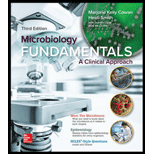
Archaea
- a. are most genetically related to bacteria.
- b. contain a nucleus.
- c. cannot cause disease in humans.
- d. lack peptidoglycan in their cell walls.
Introduction:
The domain classification consists of prokaryotes, eukaryotes, and archaea. The prokaryotes include the group of bacteria which are unicellular organisms, without a nucleus and chromosomes condensed in the cytoplasm. Archaea include the group of ancient bacteria. The domain eukaryotes include protists, fungi, Plantae, and animalia.
Answer to Problem 1Q
Correct answer:
Archaea lack peptidoglycan in their cell walls. Therefore, option (d) is correct.
Option (d) is given as “lack peptidoglycan in their cell walls”.
Explanation of Solution
Justify the reasons for the correct statement:
Archaea contains single and circular chromosomes. Ribosomes are the 70S, but their structure is similar to 80S. Nucleus and membrane-bound organelles are absent but have a bacterial-like metabolism. The peptidoglycans and cell wall are absent in archaea, but theseare present in bacteria.
Hence, option (d) is correct.
Justify the reasons for the incorrect statements:
Option (a) is given as “are most genetically related to bacteria”.
Archaea are genetically related to bacteria. Archaea initially are defined as archaebacteria. Hence, it is a wrong answer.
Option (b) is given as “contain a nucleus”.
Both archaea and bacteria are unicellular organisms and contain do not contain a nucleus. Hence, it is a wrong answer.
Option (c) is given as “cannot cause disease in humans”.
Both bacteria and archaea can be opportunistic pathogens and cause disease in humans. Hence, it is a wrong answer.
Hence, options (a),(b), and(c) are incorrect.
It was once thought that bacteria and archaea belonged to the prokaryotic domain and similar to bacteria, but later they showed some distinctive difference in their cell wall and ribosomes.
Want to see more full solutions like this?
Chapter 3 Solutions
Microbiology Fundamentals: A Clinical Approach
- Bacteria are similar to archaea in that theya. arose through endosymbiosis.b. are multicellular.c. live in extreme environments.d. are prokaryotes.arrow_forwardThe membrane lipids of archaea are most similar to those found in: a. none of the above b. chloroplasts c. mitochondria d. bacteria e. eukaryotesarrow_forwardVirusesa. are usually photosynthetic.b. consist of a single cell.c. consist of DNA or RNA and a protein coat.d. consist of ATP and a lipid coat.arrow_forward
- Archaea are distinct from bacteria becausea. some archaea form methane.b. each have different rRNA sequences.c. archaea do not have peptidoglycan cell walls.d. archaea are more closely related to eukaryotes.e. All of these are correct.arrow_forwardArchaea cells do NOT often have: a. preferences for extreme habitats. b. specifically identifiable ribosomal RNA genes. c. Branched chains in their membrane lipids. d. Ester linkages in their phospholipids. e. Pseudomurein cell wall containing no N-acetylmuramic acid and no D-amino acids. f. circular chromosomes.arrow_forwardThis group of prokaryotes are not actually closely related but are grouped together because they are all bacillus-shaped and adapted to low oxygen environments. O A. Archaea O B. Firmicutes O C. Cyanobacteria D. CFB bacteriaarrow_forward
- Which of the following is NOT a characteristic for bacteria in general? a. Plasma membrane has no saccharide units b. Sterols is one of its major outer membrane component c. Genome present in the nucleiod region of the cytosol d. Granules are mostly polysaccharide in naturearrow_forwardA bacterium has the following characteristics:∙ It adheres to the human intestinal lining using a feature that protects it from phagocytes, bacteriophages, and dehydration∙ It can survive being boiled∙ It contains no plasmids and relatively little peptidoglycanWhich of the following characteristics allows this bacterium to adhere to the intestinal lining? Group of answer choices A. fimbriae B. pili C. an endospore D. a flagellumarrow_forwardwas used by Joseph Lister to clean wounds and surgical instruments: A.Antibiotics b.Chlorine water Carbonic acid dAntitoxins e. Carbolic acid Which one of the following does not apply to the bacterial glycocalyx? It is not responsible for virulency b .It allows the organism to resist drying C. It may allow an organism to resist phagocytosis d.It is composed of carbohydrates E. It is enclosed by the cell wallarrow_forward
- Bacteria that can survive in extreme environments are called: a-Anaerobes b-Saprophytes c-Aerobes d-Archaebacteriaarrow_forwardFrom the given option below what is the community of prokaryotes surrounded by slime and adhering to a surface called, a. plasmid. b. flagellum. c. endospore. d. biofilm. 8:47 Farrow_forwardEndospores : A. are a dormant form of a bacterium AND are formed by members of medically relevant groups of bacteria. B. are a form of reproduction AND are formed by members of medically relevant groups of bacteria. C. are a dormant form of a bacterium AND are involved in anaerobic respiration. D. are formed by members of medically relevant groups of bacteria AND are involved in anaerobic respiration.arrow_forward
 Human Anatomy & Physiology (11th Edition)BiologyISBN:9780134580999Author:Elaine N. Marieb, Katja N. HoehnPublisher:PEARSON
Human Anatomy & Physiology (11th Edition)BiologyISBN:9780134580999Author:Elaine N. Marieb, Katja N. HoehnPublisher:PEARSON Biology 2eBiologyISBN:9781947172517Author:Matthew Douglas, Jung Choi, Mary Ann ClarkPublisher:OpenStax
Biology 2eBiologyISBN:9781947172517Author:Matthew Douglas, Jung Choi, Mary Ann ClarkPublisher:OpenStax Anatomy & PhysiologyBiologyISBN:9781259398629Author:McKinley, Michael P., O'loughlin, Valerie Dean, Bidle, Theresa StouterPublisher:Mcgraw Hill Education,
Anatomy & PhysiologyBiologyISBN:9781259398629Author:McKinley, Michael P., O'loughlin, Valerie Dean, Bidle, Theresa StouterPublisher:Mcgraw Hill Education, Molecular Biology of the Cell (Sixth Edition)BiologyISBN:9780815344322Author:Bruce Alberts, Alexander D. Johnson, Julian Lewis, David Morgan, Martin Raff, Keith Roberts, Peter WalterPublisher:W. W. Norton & Company
Molecular Biology of the Cell (Sixth Edition)BiologyISBN:9780815344322Author:Bruce Alberts, Alexander D. Johnson, Julian Lewis, David Morgan, Martin Raff, Keith Roberts, Peter WalterPublisher:W. W. Norton & Company Laboratory Manual For Human Anatomy & PhysiologyBiologyISBN:9781260159363Author:Martin, Terry R., Prentice-craver, CynthiaPublisher:McGraw-Hill Publishing Co.
Laboratory Manual For Human Anatomy & PhysiologyBiologyISBN:9781260159363Author:Martin, Terry R., Prentice-craver, CynthiaPublisher:McGraw-Hill Publishing Co. Inquiry Into Life (16th Edition)BiologyISBN:9781260231700Author:Sylvia S. Mader, Michael WindelspechtPublisher:McGraw Hill Education
Inquiry Into Life (16th Edition)BiologyISBN:9781260231700Author:Sylvia S. Mader, Michael WindelspechtPublisher:McGraw Hill Education





